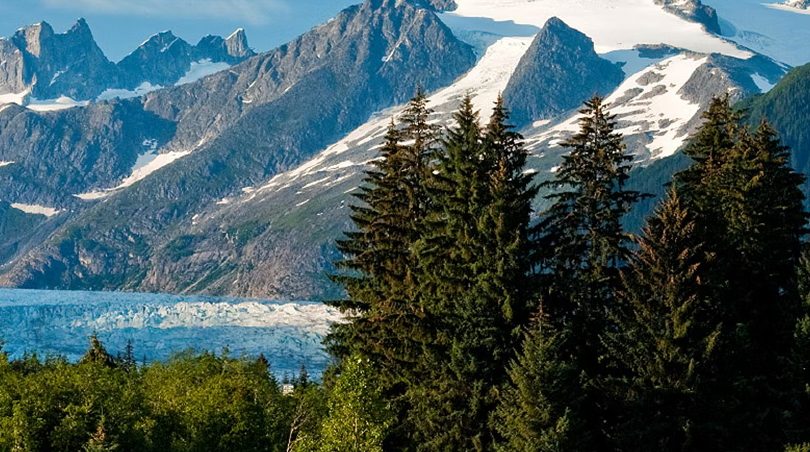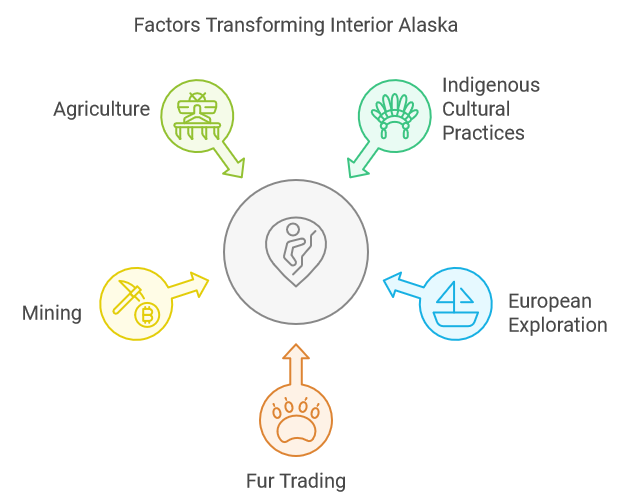Interior Alaska is a vast and unique region that plays a significant role in the state’s identity and geography. Known for its dramatic landscapes and harsh climate, this central part of Alaska encompasses a rich tapestry of cultural and natural history. It serves as a vital hub for Indigenous communities, settlers, and a diverse range of wildlife, all adapting to the challenges posed by the environment. The significance of Interior Alaska lies not only in its geographical features but also in its cultural heritage and economic activities, which have evolved over centuries.
This blog aims to explore the various facets of Interior Alaska, including its geographical layout, cultural richness, and historical context. By delving into these aspects, we will gain a deeper understanding of what defines this remarkable region.
1. Definition and Geographic Boundaries
Definition of Interior Alaska
Interior Alaska is primarily characterized as a large, central region of the state, distinguished by its remoteness and geographic isolation. This expansive area is marked by a diverse array of natural features, including rivers, valleys, and mountain ranges, contributing to its unique ecological and cultural landscape(Alaska Adventure Center)(Alaska History).
Geographical Boundaries
- North: The northern boundary of Interior Alaska is defined by its proximity to the Arctic and northwest Alaska, where the traditional Athabaskan villages transition into Eskimo settlements.
- East: To the east, Interior Alaska meets the political boundary of Canada at the 141st meridian, which serves as a clear delineation of the region.
- South: The southern boundary is distinctly marked by the Alaska Range, which acts as a natural separator from Southcentral Alaska, providing a geographic definition that enhances the region’s isolation(Travel Alaska)(Alaska History).
2. Landscape and Natural Features
Diverse Landscapes
Interior Alaska is renowned for its striking and varied landscapes, which include swampy river flats, heavily timbered valleys, rolling hills, and the foothills of mountain ranges. The terrain is shaped by glacial activity, creating a unique ecological environment that supports diverse flora and fauna. The region’s low-lying areas often feature wetlands and river deltas, while its higher elevations provide panoramic views of the surrounding wilderness(Travel Alaska)(Alaska History). This varied topography not only contributes to the natural beauty of Interior Alaska but also affects local weather patterns and ecosystems.
Key Rivers
Two of the most significant rivers in Interior Alaska are the Yukon and Tanana Rivers. These rivers have historically served as vital transportation routes for Indigenous peoples and later settlers, facilitating trade and communication. The Yukon River, one of the longest rivers in North America, stretches for over 1,980 miles, providing crucial access to remote communities and abundant natural resources(Alaska Adventure Center)(Alaska History). The Tanana River, a tributary of the Yukon, plays a similarly important role, connecting various communities and supporting local economies through fishing and transportation. Both rivers are essential for sustaining the lifestyles of those living in the region, offering routes for travel and resources for sustenance.

3. Climate
Extreme Seasonal Fluctuations
The climate of Interior Alaska is characterized by extreme seasonal fluctuations, making it one of the most challenging environments in the state. Winters are long and harsh, with temperatures often plummeting well below freezing, leading to significant snowfall and icy conditions. In contrast, summers are relatively short but can be surprisingly warm, with temperatures sometimes exceeding 80°F (27°C)(Travel Alaska)(Alaska History). This dramatic shift in weather not only impacts the daily lives of residents but also influences the region’s wildlife and vegetation, resulting in unique adaptations among species that thrive in such variable conditions.
The seasonal extremes also affect the cultural practices of Indigenous communities, who have developed traditional knowledge and practices to adapt to the rigorous demands of their environment(Alaska Adventure Center)(Alaska History). Understanding these climatic conditions is essential for appreciating the resilience of the people and ecosystems in Interior Alaska.
4. Communities and Population
Key Communities
Interior Alaska is home to several communities, with Fairbanks standing out as the largest city in the region. Known as the “Golden Heart City,” Fairbanks serves as a central hub for commerce, education, and cultural activities, making it a vital part of the region’s infrastructure and economy. The city offers various amenities, including shopping centers, schools, and recreational opportunities, attracting both residents and visitors(Travel Alaska)(Alaska History).
In addition to Fairbanks, smaller towns such as Tok and Delta Junction also play important roles in the community fabric of Interior Alaska. Tok, often referred to as the “Gateway to the Interior,” serves as a significant stop for travelers heading into the region, providing essential services and hospitality. Delta Junction, located at the end of the Alaska Highway, is known for its agricultural endeavors and offers a quieter, rural lifestyle for its residents(Alaska Adventure Center)(Alaska History).
Population Characteristics
The population of Interior Alaska is relatively sparse compared to other regions of the state, primarily due to its vast size and harsh environmental conditions. Many residents live in remote areas, relying on a close-knit community for support and social interaction. The challenges posed by the extreme climate, including long, cold winters and limited accessibility, have shaped the way of life for those living in this region(Travel Alaska)(Alaska History).
Residents often adapt to these challenges by developing self-sufficient lifestyles, engaging in subsistence activities such as hunting, fishing, and gardening. Many also embrace outdoor recreational opportunities during the summer months, capitalizing on the brief window of warmer weather(Alaska Adventure Center)(Alaska History). The ability to adapt and thrive in such an environment speaks to the resilience of the communities in Interior Alaska, fostering a unique culture deeply connected to the land and its resources.

5. Historical Context
Cultural Heritage
The historical context of Interior Alaska is deeply rooted in the rich cultural heritage of Indigenous communities. For thousands of years, groups such as the Athabaskans, Yupik, and other Native Alaskan peoples have inhabited this region, relying on the land for sustenance and cultural practices. They engaged in hunting, fishing, and gathering, developing a profound relationship with the environment that shaped their lifestyles and traditions(Travel Alaska)(Alaska History).
With the arrival of European explorers and settlers in the 18th and 19th centuries, new economic activities emerged, notably fur trading and mining. The fur trade, initiated by Russian explorers and traders, significantly impacted Indigenous communities, often altering their traditional ways of life. Following the discovery of gold in the late 1800s, a mining boom led to an influx of settlers and miners, which further transformed the landscape and demographics of Interior Alaska(Travel Alaska)(Alaska History). Farming also developed as settlers sought to cultivate the fertile river valleys, introducing new agricultural practices to the region.
Influence of Environment on Lifestyle
The challenging landscape and climate of Interior Alaska have profoundly influenced the ways of life for its inhabitants. The harsh winters and short growing seasons dictate the types of crops that can be cultivated and the methods used for hunting and gathering. Traditional knowledge of seasonal patterns and animal migrations remains essential for survival(Travel Alaska)(Alaska History). Indigenous peoples have long adapted their practices to the environment, utilizing available resources in sustainable ways that reflect their deep understanding of the land.
The remoteness of Interior Alaska has also fostered a strong sense of community among its residents, encouraging cooperation and resilience in the face of environmental challenges. The lifestyle here is often defined by a close-knit connection to the land, where the rhythms of nature dictate daily activities and cultural practices(Alaska Adventure Center)(Alaska History).
Conclusion
In summary, Interior Alaska is a region marked by its geographical isolation, diverse landscapes, and extreme climate, all of which contribute to its unique character. The historical context of the area, shaped by Indigenous cultures, fur trading, and mining, has profoundly influenced the lifestyles of its inhabitants.
Reflecting on the significance of Interior Alaska within the broader context of Alaska, we see a rich tapestry of cultural heritage and environmental adaptation that continues to thrive. Understanding this region enhances our appreciation for Alaska as a whole, highlighting the resilience and ingenuity of its people in navigating one of the most challenging environments on Earth. For further exploration of these themes, consider visiting sources like Travel Alaska and Alaska History.
Resources
Here are the sources used for the research on Interior Alaska:
- Travel Alaska: This website provides comprehensive information on the geography, climate, and cultural significance of Interior Alaska. You can explore more about the region’s landscapes and attractions here.
- Alaska History: A valuable resource for understanding the historical context of Interior Alaska, including insights into Indigenous cultures and the impact of fur trading and mining. Learn more at Alaska History.
- Alaska Adventure Center: This site offers information about the natural features and outdoor activities available in Interior Alaska, emphasizing the region’s diverse landscapes. More details can be found here.
